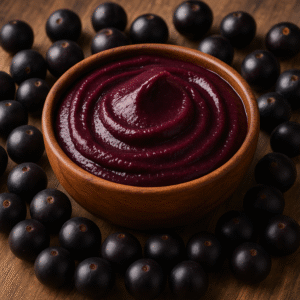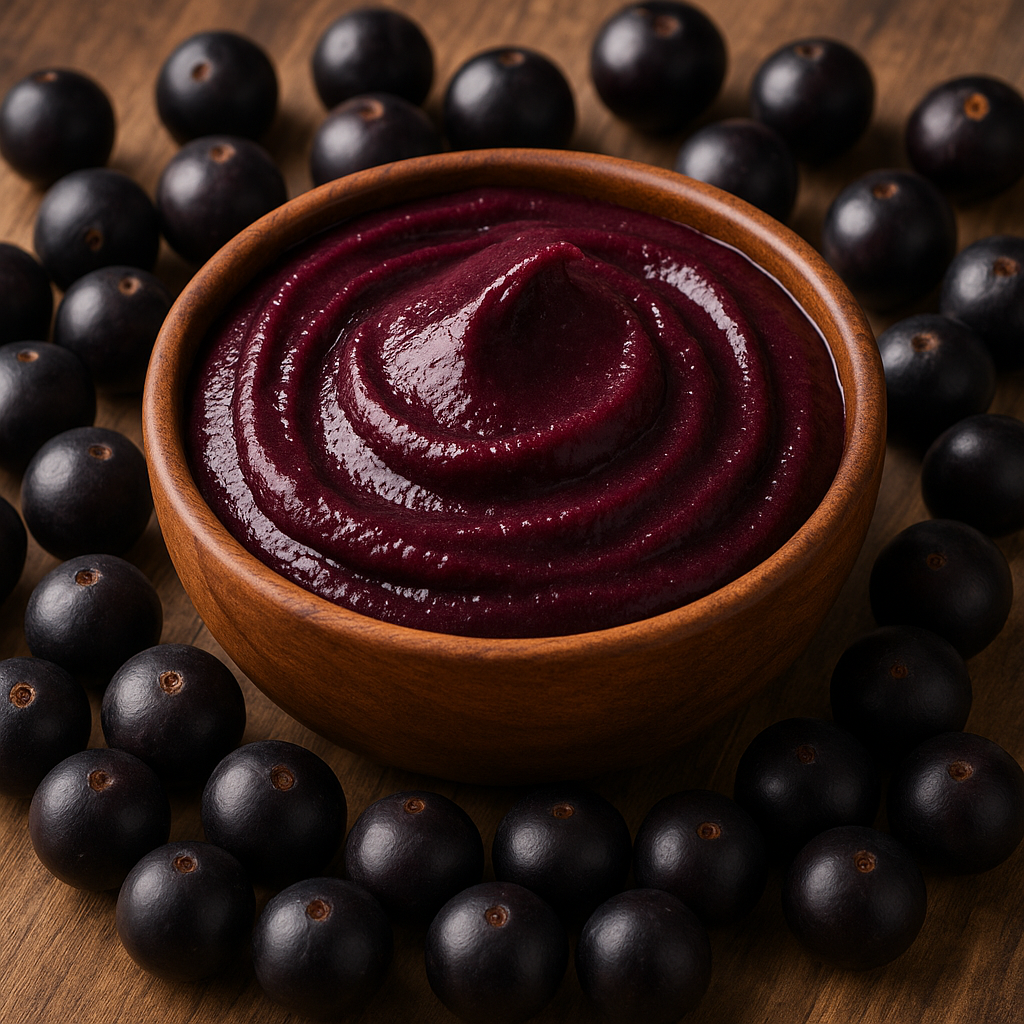The açaí berry, harvested from the majestic açaí palm (Euterpe oleracea), is one of the Amazon’s most iconic and powerful natural gifts. Native to the Brazilian rainforest, this small dark-purple fruit has gained global recognition in recent decades and is now hailed as a true superfood—packed with nutrients, antioxidants, and health-boosting properties.
But before it became a global sensation served in smoothie bowls and supplements, açaí had a long history of traditional use among Indigenous and riverine communities in the Amazon. Its nutritional density and versatility made it a staple food source long before the rest of the world caught on.
In this post, you’ll discover:
-
The origins and cultural significance of açaí
-
Its most impressive health benefits
-
Traditional and modern ways to consume it
-
Its growing use in skincare and haircare products
-
And why açaí oil is becoming a star ingredient in natural beauty treatments
The Origins of Açaí
Açaí grows in clusters on tall, slender palm trees that can reach up to 25 meters in height. These palms flourish in swampy and riverine environments throughout the northern regions of Brazil, especially in the states of Pará and Amapá.
The word “açaí” comes from the Tupi language: ïwasa’i, which translates to “fruit that cries” or “fruit that sheds water.” Indigenous peoples and riverside communities have relied on açaí for centuries, not only as a major part of their diet but also as a source of strength, healing, and even spiritual nourishment.
Interestingly, the way açaí is consumed in its place of origin is quite different from the way it’s known in major cities and abroad. In the Amazon, açaí is typically eaten unsweetened and savory, served with manioc flour, dried fish, or shrimp. This version is often enjoyed during lunch or dinner and is deeply ingrained in the local culture.
Nutritional Profile and Health Benefits
What makes açaí a true superfood is its impressive nutritional profile. While small in size, the berry delivers a dense concentration of health-enhancing compounds.
1. Rich in Antioxidants
Açaí contains powerful plant compounds called anthocyanins, which give it its signature dark purple hue. These antioxidants help neutralize free radicals, reducing inflammation and supporting cellular health.
2. Heart-Healthy Fats
Unlike most fruits, açaí is high in healthy fats, especially omega-9 (oleic acid) and omega-6 (linoleic acid). These fats help improve cholesterol balance and promote cardiovascular health.
3. High in Fiber
Fiber is essential for digestive health and blood sugar regulation, and açaí offers a good amount—supporting gut health and satiety.
4. Packed with Vitamins and Minerals
Açaí provides a range of essential micronutrients, including vitamin E, potassium, calcium, and magnesium, all of which contribute to bone health, skin renewal, and proper muscle function.
5. Natural Energy Booster
Due to its calorie and healthy fat content, açaí is an ideal natural energy source for athletes and active individuals.
Traditional and Modern Uses of Açaí
Besides being consumed in its whole or blended form, açaí is now found in a variety of food and wellness products:
-
Frozen pulp for smoothie bowls
-
Juice blends and energy drinks
-
Nutritional supplements and capsules
-
Protein powders and meal replacements
-
Beauty and skincare products, especially açaí oil
The açaí industry has expanded globally, but its heart remains in the Amazon, where it continues to sustain both local diets and economies.
Açaí in Skincare and Haircare
One of the most exciting recent developments is the use of açaí oil in natural cosmetics. Extracted from the pulp of the fruit, açaí oil is rich in essential fatty acids and antioxidants, making it ideal for promoting both hair and skin health.
Benefits for Hair:
-
Repairs dry and damaged strands
-
Strengthens hair fiber and reduces breakage
-
Adds shine and smoothness
-
Helps control frizz and protects against heat
-
Deeply nourishes without leaving residue
Benefits for Skin:
-
Deep hydration without clogging pores
-
Helps reduce signs of aging and fine lines
-
Protects against environmental stress
-
Supports skin elasticity and regeneration
Because of its stability and rapid absorption, açaí oil is used in serums, masks, conditioners, and even body lotions.
Fun Facts About Açaí
-
In the state of Pará, açaí is so popular that it’s consumed more than milk.
-
Over 1.5 million tons of açaí are harvested every year in Brazil.
-
The seeds make up about 80% of the fruit’s volume—and are now being studied for use in bioenergy and compost.
-
Açaí trees are considered renewable resources when harvested responsibly, making them important in sustainable forest economies.
How to Consume Açaí the Healthy Way
While açaí is often marketed as a health food, not all açaí products are created equal. Some versions are loaded with sugar, artificial syrups, and caloric toppings that negate the fruit’s natural benefits.
To get the most out of açaí:
-
Choose 100% pure or organic açaí pulp
-
Avoid heavily sweetened blends with guaraná syrup
-
Mix with natural fruits, unsweetened granola, or nut butters
-
For external use, opt for cold-pressed açaí oil from trusted brands

Restore Radiance with Nature’s Power
Treat your hair to the antioxidant-rich care it deserves. Amazon Series Acai Oil Treatment, 4 Fluid Ounce is a premium, lightweight formula that nourishes, repairs, and restores shine using the pure essence of açaí oil. Perfect for dry, frizzy, or chemically treated hair, this treatment brings the power of the Amazon straight to your beauty routine.
Discover the Enchantment of Jabuticaba!
Immerse yourself in the unique charm of Brazil’s jabuticaba—a delightful purple gem that captivates both taste buds and gardens. Whether you’re a passionate gardener or a culinary explorer, this article is a must-read.

